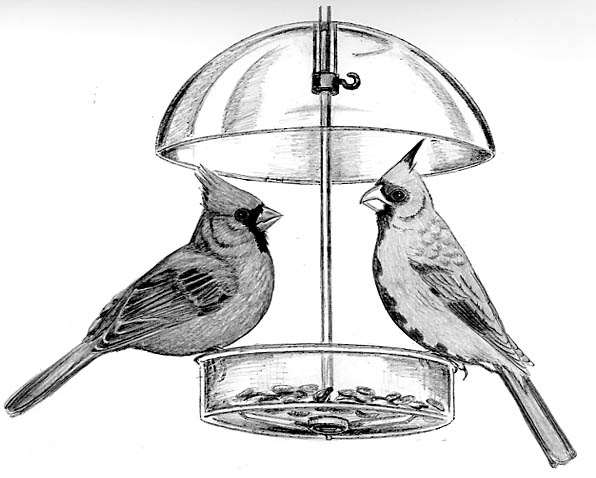
Dear Bird Folks,
Is a Pyrrhuloxia another name for a cardinal? A friend of mine sent me a postcard from Arizona. The picture on the front of the card depicted several birds. One of the birds was a cardinal but the caption read “Pyrrhuloxia.” I don’t know a lot about birds, but I do know what a cardinal looks like. Why did they call it a Pyrrhuloxia?
– Dustin, Berlin, NH
It’s not a cardinal, Dustin,
I know the bird on the front of your postcard looks like a cardinal, but it isn’t. It’s a Pyrrhuloxia. Yes, there really is a bird called a “Pyrrhuloxia.” The Pyrrhuloxia, a bird whose name looks like a bad hand in Scrabble, is basically a cardinal wannabe, and who can blame it? Cardinals have a look that humans can’t get enough of. The Northern Cardinal is the state bird of seven U.S. states; two professional sports teams have been named after it and several colleges have it as their mascot. So it makes perfect sense that another bird would also want to look like a cardinal. It’s a way of getting a piece of the spotlight…much the same way dumpy, middle-aged men dress like Elvis. What I don’t get is why the bird would allow itself to be called Pyrrhuloxia? Who the heck can even pronounce it? Talk about making a bad career move. It’s like a cookie trying to compete with Oreos by calling itself “Hydrox.” I think if the birds where called something like, say, “Vegas Cardinals,” it would change their image completely.
How did the Pyrrhuloxia end up with such a scary looking name? And what does Pyrrhuloxia mean? It’s all Greek to me. No, really, it is Greek. The Pyrrhuloxia’s name comes from two Greek words: The first one means “flame,” which has to do with the male’s red breast; the second means “crooked,” referring to its large beak. Found in the desert southwest, Pyrrhuloxias typically like drier habitats than cardinals do. Because of its preference for dry habitat some folks, who can’t figure out how to say Pyrrhuloxia, simply refer to it as the “desert cardinal.” That isn’t bad, but Vegas Cardinal would be so much better. Hey, maybe I should copyright that name!
Superficially the Vegas Cardinal© does look like a female Northern Cardinal, Dustin, but here are a few key field marks that to help you identify which is which. Both birds have a crest, but the cardinal’s crest has a ragged appearance, while the Pyrrhuloxia’s crest is smooth, tall, and often sticks straight up, making the bird look like it’s wearing a traffic cone. Another thing to notice is that Pyrrhuloxias have a more curved culmen than cardinals have. I know that having a deeply curved culmen sounds like something the birds should be embarrassed about, but the culmen is nothing more then the top portion of the beak. A sharp down-curved beak gives the Pyrrhuloxias a more parrotier look. If you aren’t in the mood or are too shy to measure the bird’s culmen, a more obvious field mark is the color of the beak. Northern Cardinals have a bright red-orange beak, where as the Pyrrhuloxia’s beak is yellow in the summer and dusky in the winter, but never, ever red. (Joe McCarthy would approve.)
Pyrrhuloxias have a very limited U.S. range. They are typically found in parts of Arizona, New Mexico and Texas. A good place to look for these birds is in mesquite thickets where they use the plant’s thorny branches to protect themselves from predators. In addition, mesquite beans are an important food item and the wood of the mesquite is a source of flavoring on the birds’ steaks when they have their annual barbeque. Unfortunately, cattle ranchers have cleared many of the mesquite trees. They claim the trees compete for the rangeland grass needed for the cattle. (That’s what the birds get for eating steak.) The loss of the mesquite has likely had a negative impact on the Pyrrhuloxias. However, these desert cardinals have also benefited from humans. As backyard bird feeding expands into the southwest, Pyrrhuloxias are taking advantage of our generosity. Pyrrhuloxias and Northern Cardinals have been seen eating side by side at feeders, where they apparently get along. Occasionally though, just to show its sense of superiority, the snooty cardinal will mumble something about the Pyrrhuloxias having a deeply curved culmen and that’s when things turn ugly. I don’t blame you for being confused by your postcard, Dustin. You can’t be expected to know birds that live 2,700 miles from Berlin, NH. I also understand why you would question any bird that has the title “Pyrrhuloxia” under it. It sure looks like the worst typo ever or the name of an ointment you might use for a skin rash. But the Pyrrhuloxia is a real bird; it just has a bad name.
While we are talking about cardinals, I’d like to point out that August is when the cardinals in New England have their annual molt. Molting cardinals will sometimes lose so many head feathers at once they will look bald. This is upsetting to some people, but there is no reason to freak out or call 911. Their feathers will grow back in a few weeks. In the meantime, you can call them “Kojak Cardinals” if you want. It’s not as clever as Vegas Cardinals©, but what is?